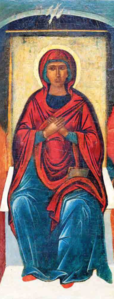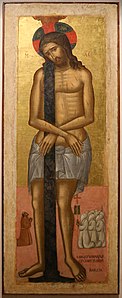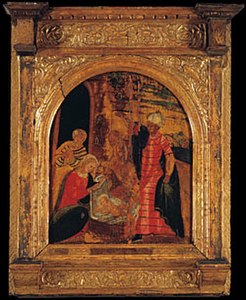Angelos Pitzamanos
Angelos Pitzamanos | |
|---|---|
 Virgin and Child with Saint John | |
| Born | 1467 |
| Died | 1535 |
| Nationality | Greek |
| Notable work | Madonna of Constantinople |
| Movement | Cretan School |
| Years active | 1482–1535 |
| Style | Maniera Greca Italian Renaissance |
| Relatives | Donatus Pitzamanos |
Angelos Pitzamanos (Greek: Άγγελος Πιτζαμάνος) (1467–1535) was a Greek Renaissance painter. The artists is sometimes referred to as Angelos Bitzamanos. He was born in Crete and migrated to Otranto, Southern Italy where he did most of his work. A contract between Andreas Pavias and Pitzamanos illustrates that Pitzamanos was his apprentice. Angelos was a student of Andreas Pavias for five years (1482-1487). It is evident that his work featured both the Greek style and Italian style of the time. Pitzamanos later became a famous master.[1][2][3][4]
History
Angelos was born on the island of Candia. His father's name was Nicholas. Both Angelos and his brother Donatos were active painters. Angelos studied under Andreas Pavias for five years. He traveled all over the Venitian Empire painting for various patrons. Some of the works were signed by him and his brother.[5]
Bizamanos painted a very famous triptych which was exhibited in Rome at the Accoramboni Palace. The triptych was acquired by Henry Walters with the Massarenti collection in 1902. The central panel features Christ and the Virgin. The left-wing shows Saint Jerome in the desert and the right features John the Baptist. The triptych was painted by Angelos Bitzamanos, an inscription on the inside left indicates Angelus/Bi/Zamanus/Pinxit. Another form of his inscription was Angelus Bizamanus Grecus Cadiotus Pinxit in Otranto. Some of these works are in the Walters Art Museum.[5][6]
Angelos was active in Crete, Dalmatia, and Italy. In 1518, he was commissioned to create an altarpiece for the Confraternity of the Holy Spirit in Komolac, Dalmatia, a colony of Venice. His brother Donata Bizamanos joined him. They painted together in Otranto and Barletta. Some other pieces included the Predella of Komolac and Icon of Visitation by Angles.[5]
Gallery
- Madonna Enthroned Detail from Pentecost Polyptych
- Christ on a Pole
- Madonna and Child
- O Madonna di Costantinopoli
- The Adoration of the Magi
See also
References
- ^ Richardson, Carol M. (2007). Locating Renaissance Art. United Kingdom: Yale University Press. p. 200. ISBN 9780300121889.
- ^ Nano Chatzidakis:The character of the Velimezis Collection
- ^ Speake, Graham (2021). Encyclopedia of Greece and the Hellenic Tradition By Vasilios Makrides. London And New York: Rutledge Taylor & Francis Group. p. 1442. ISBN 9781135942137.
- ^ Vassilaki, Maria (1990). "Some Cretan icons in the Walters Art Gallery" (PDF). Journal of the Walters Art Gallery. 48: 75–92. ISSN 0083-7156. JSTOR 20169062. Wikidata Q122544661.
- ^ a b c Vassilaki 1990, p. 81-92.
- ^ Staff Writers (May 23, 2021). "The Visitation". The Walters Art Museum. Retrieved May 23, 2021.





